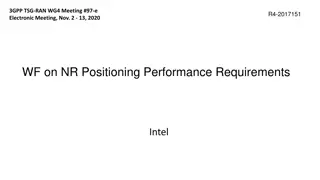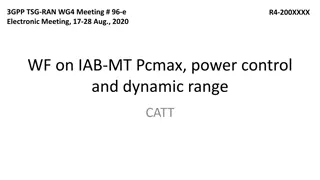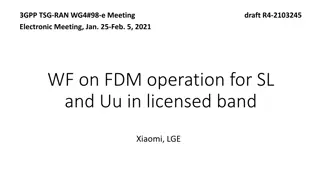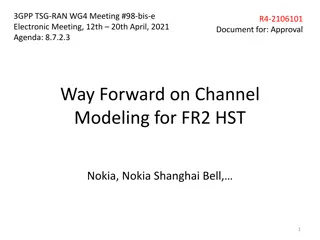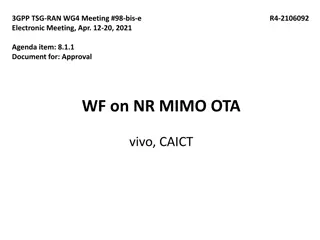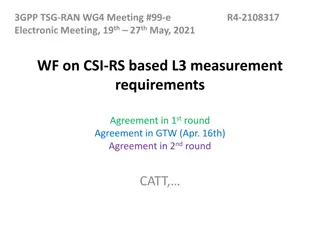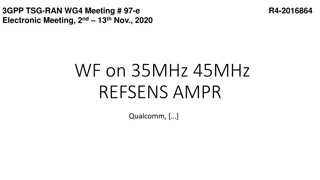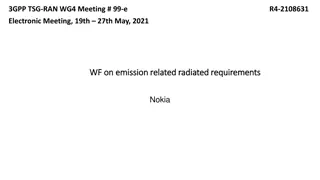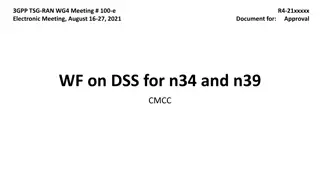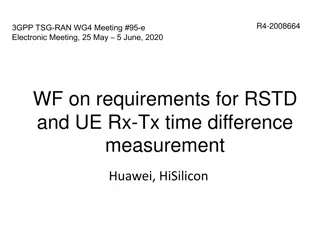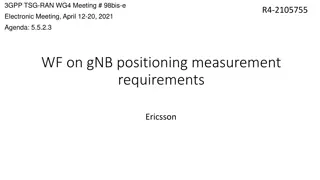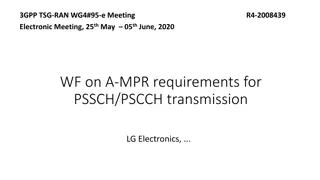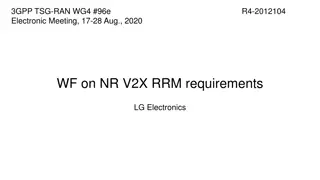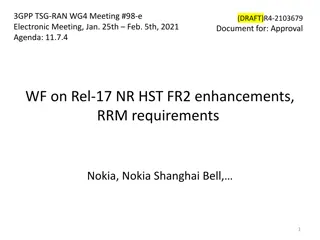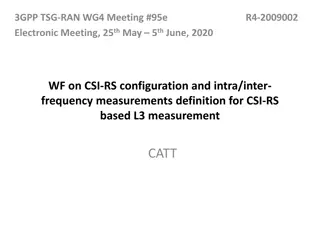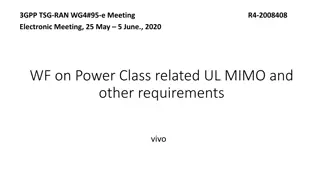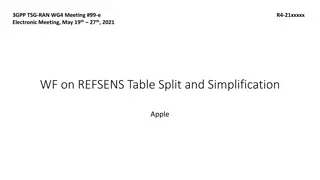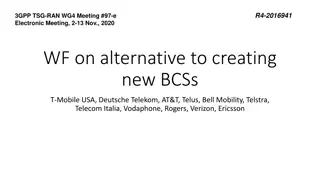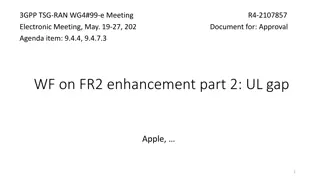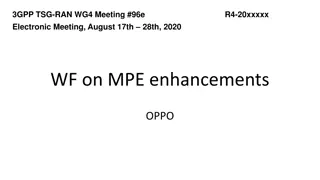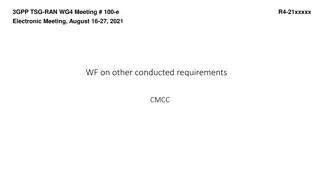Way Forward on Transparent Tx Diversity in 3GPP.TSG-RAN.WG4#94-e-Bis Meeting R4-2005652
The meeting discusses the implementation of transparent Tx Diversity for uplink full power transmission in the context of 3GPP specifications for FR1 in Release 16 and beyond. It outlines the necessary changes needed to allow UE behavior of transparent Tx Diversity, test case adaptations, power scaling requirements, and scenarios for transparent Tx Diversity application. Various scenarios are presented, detailing network configurations, scheduling methods, and considerations for transparent Tx Diversity usage. The session emphasizes the importance of adhering to specifications for enabling transparent Tx Diversity effectively.
Download Presentation

Please find below an Image/Link to download the presentation.
The content on the website is provided AS IS for your information and personal use only. It may not be sold, licensed, or shared on other websites without obtaining consent from the author. Download presentation by click this link. If you encounter any issues during the download, it is possible that the publisher has removed the file from their server.
E N D
Presentation Transcript
3GPP TSG-RAN WG4#94-e-Bis Meeting R4-2005652 Electronic Meeting, 20th 30th Apr., 2020 WF on Uplink Full Power Transmission Samsung, 1
Way Forward Transparent Tx Diversity (TxD) in Rel-16 Transparent TxD shall be allowed for FR1 in Rel-16: Necessary changes to Rel-16 RAN4 specification is needed to allow the UE behavior of transparent TxD in FR1; Accordingly RAN5 will change test cases to allow transparent TxD in FR1. From Rel-16 and beyond, SA UE declaring PC2 HPUE shall have 26dBm MOP for both 1TX port transmission and 2TX UL-MIMO (if supported) For UE with 23dBm+23dBm PA architecture, transparent TxD shall be used to have 26dBm MOP for 1TX port transmission. Rel-15 UE behavior of power scaling for precoder [1 0] and [0 1] in TS38.213 shall still be followed for UE not capable of Rel-16 ULFPTx and UE only capable of Rel-16 ULFPTx Mode-1. 2
Way Forward Clarification on Transparent TxD (1/3) Scenario-1: NW use DCI format 0_0 to schedule PUSCH for 1layer 1Tx antenna port transmission, or NW configured 1 SRS port in one SRS resource and use DCI format 0_1 to schedule codebook- based PUSCH transmission PUSCH with precoder [1] for 1layer 1Tx antenna port transmission. Transparent TxD shall be allowed in Scenario-1; If transparent TxD is used in Scenario-1: Transmission come out from two antenna connectors; General requirements in clause 6.x in TS38.101-1 apply; FFS measurement configuration for transparent TxD transmission, e.g., the way to adjustment of relative phase coherence between TX branches; the way to derive verdicts under the condition in which the active antennas are unknown; the way to derive EVM measurement results after measuring per antenna connector; etc. 3
Way Forward Clarification on Transparent TxD (2/3) Scenario-2: UE supports 2 SRS ports; NW configured 2 SRS ports in one SRS resource; NW use DCI format 0_1 to schedule codebook-based PUSCH transmission with precoder [1 0] or [0 1] in 1layer 2Tx precoder codebook, which corresponding to 2 SRS ports in the SRS resource The scheduled precoder [1 0] or [0 1] in Scenario-2 is not regarded as transparent TxD . (Intel, Samsung) In Scenario-2, can transparent TxD be applied to non-zero power 1 TX in precoder [1 0] or [0 1]? Option-1 (Samsung, Intel): No. Option-2: Yes 4
Way Forward Clarification on Transparent TxD (3/3) Scenario-3: UE supports 2 SRS ports; NW configured 2 SRS ports in one SRS resource; NW use DCI format 0_1 to schedule codebook-based PUSCH transmission with precoder [1 1] in 1layer 2Tx precoder codebook, which corresponding to 2 SRS ports in the SRS resource. The scheduled precoder [1 1] in Scenario-3 is not regarded as transparent TxD . (Qualcomm, Intel, Samsung) 5
Way Forward New Power Class Capability (Proposals on the table) Option 1 (Samsung, Huawei, LGE, Qualcomm): No need to introduce a new power-class capability because power class declaration should be applied to all transmission modes from Rel-16. Option 1a (Samsung, LGE, Qualcomm): Option 1, but if NR_NewRAT_UE_RF_Part_2 can t solve power class ambiguity issue or if transparent TxD is not allowed in Rel-16, need more discussion. Option 2 (Ericsson, OPPO, Qualcomm): Add new power class Option 2a (Ericsson): adding a new power-class capability for two-layer transmissions per NR band (Rel- 16): Note that this indication could be used also for Rel-15 UE to completely close the signaling ambiguity issue: the gNB would be made aware that a PC3 UE with UL-MIMO capability and 23 + 23 dBm implementation can meet PC2 for two-layer transmissions; the gNB would read the capability even if not a Rel-16 UE (if bits are present, they would be read). Option 2b (OPPO): Introducing a new power class capability in addition to Rel-15 power class capability to remove the power class ambiguity in single antenna port mode. Option 2c (Qualcomm): UEs transmitting over multiple antenna shall have a new power class determined as the sum of the power on all antennae Option 3 (Intel, vivo): Add new power class depending on other discussion for consistency: Option 3a (Intel): How to add depends on the outcome of EN-DC power class and UL MIMO clarifications topic in agenda 6.5.4.1 Option 3b (vivo): Settle Rel-15 first before defining UE power class capability for Rel-16. 6
Way Forward General Scope and Assumption for UL Power Transmission (ULFPTx) In Rel-16 eMIMO, FFS how to introduce UE RF requirement for ULFPTx feature in FR2: Companies are encouraged to bring CR to introduce UE RF requirement for ULFPTx feature in RAN4 May meeting. In which specification clause to capture MOP requirement for ULFPTx: MOP requirement for ULFPTx with 2 TX ports configured for FR1 should be specified in Section 6.2D; 7
Way Forward Test Configuration and Requirement Applicability for ULFPTx (1/2) For Mode 1 UE ULFPTx feature, the following applicability rule should be followed: Mode 1 UE shall only support Rel-15 nonCoherent codebook with scaled power when Rel-16 ULFPTx Mode 1 is not configured; Mode 1 UE shall also support TPMI [1 1] with full power transmission when Rel-16 ULFPTx Mode 1 is configured. UE is not expected to report the support of Mode 1 ULFPTx and full coherent codebook. Note: Since 2TX codebook considered in Rel-16 ULFPTx, so partial-coherent codebook subset is not relevant. For Mode 2 UE with 1 port configuration, no new ULFPTx MOP requirement is needed to be introduced in clause 6.2D. ULFPTx MOP requirement in this case can be guaranteed by MOP requirement for fallback DCI as captured in general requirement in clause 6.2 8
Way Forward Test Configuration and Requirement Applicability for ULFPTx (2/2) For Mode 0 UE ( the other mode ) with 2 ports configuration: RAN4 core requirement is defined based on all supported full power TPMIs, and it is up to RAN5 to select test configuration to perform test. For Mode 0 UE ( the other mode ) with 1 port configuration, no new ULFPTx MOP requirement is needed to be introduced in clause 6.2D. ULFPTx MOP requirement in this case can be guaranteed by MOP requirement for fallback DCI as captured in general requirement in clause 6.2 9
Contributions List in RAN4#94-e-Bis T-doc No. R4-2003216 R4-2003217 R4-2003330 R4-2003537 R4-2003874 R4-2003907 R4-2004056 R4-2004474 R4-2004738 R4-2004869 R4-2004977 Title On eMIMO full Tx power transmission On Transparent Tx Diversity Consideration on introduction of Tx diversity feature in Rel-16 Further Discussion on Uplink Tx Full Power Transmission FP transmission, transparent TxD and additional power-class capability Further on full power transmission in eMIMO Further discussion on UE RF requirments for eMIMO UL Full power Tx TX full power capability On NR eMIMO full power transmission Full power transmission and FR2 Enabling TX diversity for eMIMO Company Intel Corporation Intel Corporation Anritsu Corp. Samsung Ericsson OPPO vivo Qualcomm Incorporated Huawei, HiSilicon Qualcomm Incorporated Qualcomm Incorporated 10
Reference [1] R4-2005098, Email discussion summary for [94e Bis][12] NR_eMIMO_UE_RF , Samsung 11


